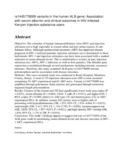rs1445776009 variants in the human ALB gene: Association with serum albumin and clinical outcomes in HIV-infected Kenyan injection substance users
Date
2021-04-21Author
Barasa, Erick
Shaviya, Nathan
Budambula, Valentine
Were, Tom
Metadata
Show full item recordAbstract
Objective: The coburden of human immunodeficiency virus (HIV) and injection substance use is high especially in coastal urban and peri-urban regions of sub-Saharan Africa. Although antiretroviral treatment (ART) has improved disease prognosis in HIV-1-infected patients, injection substance use is detrimental to these individuals. HIV-1 and injection substances use have been associated with a marked reduction in serum albumin levels. This is attributable to at least, in part, injection substance use, ARVs, HIV-1 infection, as well as host genetics. The albumin gene expression is modulated through several mechanisms including intronic consensus elements. Therefore, this study examined ALB gene rs1445776009 intronic polymorphism and its association with disease outcomes.
Methods: This cross-sectional study was conducted at Bomu Hospital, Mombasa County, Kenya. A total of 155 injection substance users (ISUs) were recruited comprising 93 ART experienced and 62 ART naive. Variant rs1445776009 was amplified through polymerase chain reaction and genotyped through restriction fragment length polymorphism.
Results: Carriers of the mutant and GG had significantly lower body mass index (P = 0.033), serum albumin (P = 0.002), CD4+ T cells (P = 0.031), and higher HIV-1 RNA copies (P = 0.018) relative to wild type, CC and heterozygous, CG; in ART-experienced ISUs. In addition, mutant GG carriers were at higher odds of presenting with hypoalbuminemia (OR, 1.933; 95% CI, 1.524–4.664; P = 0.033), underweight (OR, 2.412; 95% CI, 1.124–5.782; P = 0.026), immunosuppression (OR, 3.036; 95% CI, 1.957–9.633; P = 0.021), and high-density HIV viremia (OR, 1.836; 95% CI, 1.134–6.298; P = 0.016).
Conclusion: This study’s findings appear to suggest that loci rs1445776009 of the ALB gene could be modulating serum albumin levels and disease outcomes in HIV-1 ART-experienced ISUs.
Collections
- Journal Articles [411]

